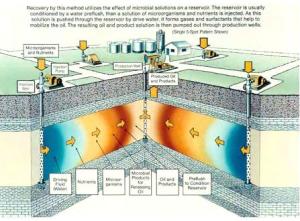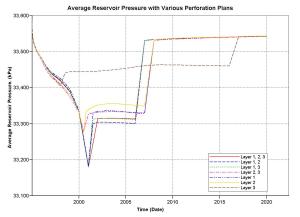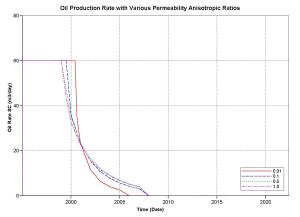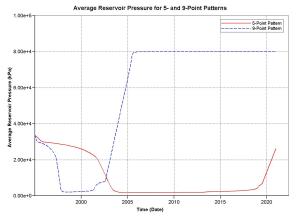Microbial Enhanced Oil Recovery
June 24, 2010 11 Comments
Note: This post was modified from a term project report which is submitted in partial fulfillment of the requirement of an Enhanced Oil Recovery course in 2008. In this report, a brief history of Microbial Enhanced Oil Recovery (MEOR), current status of MEOR, classification of MEOR, research areas, microorganisms for MEOR, advantages and disadvantages of MEOR, and screening criteria of MEOR were summarized.
1. Introduction
Enhanced Oil Recovery (EOR)
Discoveries of new reservoirs, is a high-risk business that companies undertake hoping to achieve a correspondingly high return. Sometimes they are successful but more often they are not. In many cases, increasing the recovery of oil from existing reservoirs can be less expensive than exploration and less risky as well. The reservoir will have already been partially developed therefore wells and surface production facilities are already in place1.
Oil Recovery
Oil Recovery Factor: also called overall hydrocarbon displacement efficiency, the volume of hydrocarbon displaced divided by the volume of hydrocarbon in place at the start of the process measured at the same conditions of pressure and temperature.
Where,
Ev= macroscopic (volumetric) displacement efficiency; and
ED= microscopic (volumetric) hydrocarbon displacement efficiency.
Microbial Enhanced Oil Recovery
Microbial enhanced oil recovery refers to the use of microorganisms to retrieve additional oil from existing wells, thereby enhancing the petroleum production of an oil reservoir. In this technique, microorganisms are introduced into oil wells to produce harmless by-products, such as slippery natural substances or gases, all of which help propel oil out of the well. Because these processes help to mobilize the oil and facilitate oil flow, they allow a greater amount to be recovered from the well2.
Mechanisms of MEOR
The use of microorganisms and their metabolic products to enhance oil production involves the injection of selected microorganisms into the reservoir and the subsequent stimulation and transportation of their in-situ growth products in order that their presence will aid in further reduction of residual oil left in the reservoir after secondary recovery is exhausted. The MEOR is unlikely to replace conventional EOR methods, because MEOR itself has certain constraints. This unique process seems superior in many respects, however, because self-duplicating units, namely the bacteria cells, are injected into the reservoir and by their in-situ multiplication they magnify their beneficial effects3. Some of the mechanisms proposed by which these microbial agents could stimulate oil release are shown in Table 1.
Table 1. Microbial products & their contribution to EOR4
2. History of Microbial Enhanced Oil Recovery
First Stage: Initial (~1975)
In 1895,Miyoshi first reported the growth of a mould culture on n-alkanes5. In 1926, Bastin did the first extensive microbiological study describing the widespread presence of SRB in oil-producing wells6. At the same year, Beckman suggested that microorganisms could be used to release oil from porous media7. Later in 1946, as the most important founder of MEOR, ZoBell patented a process for the secondary recovery of petroleum, using anaerobic, hydrocarbon-utilizing, sulfate-reducing bacteria such as Desulfovibrio species in situ8. The first field test was carried out in the Lisbon field, Union County, AR in 19549. Kuznetsov et al. found that bacteria discovered in some oil reservoirs in the Soviet Union produced 2 gm of CO2 per day per ton of rock, in 196310.
Second Stage: Developmental (1975~1996)
From 1970s to late 1990s, MEOR research was boosted by the petroleum crisis and later became a scientific substantiated EOR method. Many international meetings were periodically organized on the MEOR topic and proceedings volumes with the advances in the knowledge and practice of MEOR have been published. Several books on MEOR were also published4.
Third Stage: Rapid (1996~)
From late 1990s, modern biological methods began to be applied on the MEOR research, such as Molecular Ecological Technique of Microbes, Protoplast Fusant Technology, and Recombination DNA Technology11,1 2.
3. Current Status of MEOR
The research of MEOR has been done worldwide, and most of oil produce countries have applied this technology into oil fields for pilot tests. Recently this technology has been widely used in oilfields of China, such as Daqing, Shengli, Jilin, Dagang, Liaohe, Henan, Changqing, Xinjiang, and Qinghai.
4. Classification of MEOR
Mainly, MEOR is classified as surface MEOR and underground MEOR based on the place where microorganisms work. For surface MEOR, biosurfactand (Rhamnolipid13), biopolymer (xanthan gum14), and enzyme15 are produced in the surface facilities. These biological products are injected into the target place in the reservoirs as chemical EOR methods. While, for underground MEOR, microorganisms, nutrients and/or other addictives are injected into the reservoir and let them sustain, grow, metabolize, and ferment underground.
Based on the source of microorganisms, underground MEOR is categorized into in-situ MEOR and indigenous MEOR. While according to procedures of processes, underground MEOR is sorted as:
- Cyclic Microbial Recovery (Huff and Puff, Single Well Stimulation)
- Wax Removal and Paraffin Inhibition (Wellbore Cleanup)
- Microbial Flooding Recovery
- Selective Plugging Recovery
- Acidizing/Fracturing
a. Cyclic Microbial Recovery
A solution of microorganisms and nutrients is introduced into an oil reservoir during injection. The injector is then shut in for an incubation period allowing the microorganisms to produce carbon dioxide gas and surfactants that help to mobilize the oil. The well is then opened and oil and products resulting from the treatment are produce. This process may be repeated. Fig.1 illustrates this technology.
Fig.1 Illustration of Cyclic Microbial Recovery16
b. Microbial Flooding Recovery
Recovery by this method utilizes the effect of microbial solutions on a reservoir. The reservoir is usually conditioned by a water preflush, then a solution of microorganisms and nutrients is injected. As this solution is pushed through the reservoir by drive water, it forms gases and surfactants that help to mobilize the oil. The resulting oil and product solution is then pumped out through production wells. Fig.2 diagrammatized this technology as below.
Fig.2 Illustration of Microbial Flooding Recovery16
c. Selective Plugging Recovery
Injection of bacterial suspensions followed by nutrients to produce biopolymer and microbial itself, which may plug the high permeability zone in the reservoir. The reduction of permeability would change the inject profile and achieve conformance control. Fig.3 schemed this technology.
Fig.3 Illustration of Selecting Plugging Recovery3
5. Research Areas
From the above introduction, the research areas of MEOR could be concluded as history, geology, chemistry, microbiology, fluid mechanics, petroleum engineering, genetic engineering, chemical engineering, geotechnical engineering, environmental engineering, mechanisms of MEOR, transportation of bacteria, industrial participation, information technology, and economics. That requires education, cooperation between historian, geologist, chemist, microbiologist, production engineer, reservoir engineer, geotechnical engineer, environmental engineer, accountant, finance manager, information technologist, mathematician, and others.
6. Microorganisms for MEOR
a. Characteristics of Bacteria16
1) Dynamic ecology with many species
2) Growth determined by environment
i. Nutrients: cell material and energy
ii. Physical
iii. Chemical
iv. Biological
b. The microorganisms for MEOR should have the following potential properties:
- Small Size
- Resistant to High Temperatures
- Resistant against High Pressure
- Capability of Withstand Brine and Seawater
- Anaerobic Using of Nutrients
- Unfastidious Nutritional requirements
- Appropriate Biochemical Construction for Production Suitable Amounts of MEOR Chemicals
- Lack of any Undesirable Characteristics
Here, undesirable characteristics mean permeability reduction (damage the formation where a large amount of remaining exist), corrosion, and souring.
7. Advantages and Disadvantages of MEOR
a. Advantages of MEOR4
- The injected bacteria and nutrient are inexpensive and easy to obtain and handle in the field
- Economically attractive for marginally producing oil fields; a suitable alternative before the abandonment of marginal wells
- According to a statistical evaluation (1995 in U.S.), 81% of all MEOR projects demonstrated a positive incremental increase in oil production and no decrease in oil production as a result of MEOR processes
- The implementation of the process needs only minor modifications of the existing field facilities
- The costs of the injected fluids are not dependent on oil prices
- MEOR processes are particularly suited for carbonate oil reservoirs where some EOR technologies cannot be applied with good efficiency
- The effects of bacterial activity within the reservoir are magnified by their growth whole, while in EOR technologies the effects of the additives tend to decrease with time and distance
- MEOR products are all biodegradable and will not be accumulated in the environment, so environmentally friendly
b. Disadvantages of MEOR17
- Safety, Health, and Environment (SHE)
- A better understanding of the mechanisms of MEOR
- The abilibity of bacteria to plug reservoirs
- Numerical simulations should be developed to guide the application of MEOR in fields
- Lack of talents
8. Screening Criteria for MEOR
Table 2. Screening Criteria for MEOR by NIPER and RAMChemical18
a. Great achievements
MEOR has developed for decades. A series of fundamental research work has been done. Several pilot tests have been applied in the fields.
b. Promising EOR method
The success of research work and pilot tests makes this technology is attractive in the industry. This cost-effective method could contribute more in oil production, especially in mature oil fields.
c. Need more efforts
Since this technology has developed for a relatively long time, and has great achievements, to turn the promising into reality needs more efforts. The modern biological technology accelerates MEOR, which needs money and talents.
10.References
- Microbial Enhanced Oil Recovery (MEOR). Sajjadian, V.A., www.ripi.ir/lang/seminars/82-7-29/Sajjadian.pdf. Downloaded 22nd December 2008.
- Microbial Enhanced Oil Recovery. BioBasics, http://www.biobasics.gc.ca/english/View.asp?x=793. Downloaded 22nd December 2008.
- Donaldson, E.C., Chilingarian, G.V., and Yen, T.F. 1989. Development in Petroleum Science, 22: Microbial Enhanced Oil Recovery, 9. Amsterdam, Netherlands: Elsevier Science Publishers B.V..
- Lazar, I., Petrisor, I.G., and Yen, T.F. 2007. Microbial Enhanced Oil Recovery (MEOR). Petroleum Science and Technology 25 (11): 1353-1366.
- Miyoshi, M. 1895. Die durchbohrung von membranen durch pilzfäden. Jahrbücher für wissenschaftliche Botanik 28: 269–289.
- Bastin, E.S. 1926. The problem of the natural reduction of sulphates. AAPG Bulletin 10 (12): 1270–1299.
- Beckman, J.W. 1926. The Action of Bacteria on Mineral Oil. Industrial Engineering Chemical News, 4 (10):3.
- Zobell, C.E. 1946. Bacteriological Process for Treatment of Fluid-Bearing Earth Formations. U.S. Patent 2,413,278.
- Yarbrough, H. F., and Coty, F. V. 1983. Microbially enhancement oil recovery from the Upper Cretaceous Nacafoch formation Union County, Arkansas. Proceedings of 1982 International Conference on MEOR, Donaldson, E. C. and Benett Clark, J. B. (Eds.), Afton, Oklahoma: 149–153.
- Kuznetsov, S.I., Ivanov, M.V., and Lyalikova, N.N. 1963. Introduction to Geological Microbiology, 252. New York City: McGraw-Hill.
- Skovhus, T. L., Højris, B., Saunders, A.M., Thomsen, T.R., Agerbæk, M., and Larsen, J. 2007. Practical Use of New Microbiology Tools in Oil Production. Paper SPE 109104 presented Offshore Europe 2007, Aberdeen, Scotland, U.K. 4-7 September.
- Wu, Q., Zhang, Z., Yu, L, Huang, L, and Yang, P. 2007. Construction of a fusion bacterial strain and the profile control characteristics of it. Journal of Xi’an Shiyou University (Natural Science Edition), 22 (2): 41-44.
- Banat, I.M. 1995. Biosurfactants Production and Possible Uses in Microbial Enhanced Oil Recovery and Oil Pollution Remediation: A Review. Bioresource Technology 51 (1):1-12.
- G.P. Lindblom, D.G. Ortloff, and J.T. Patton. 1967. Displacement of Oil from Partially Depleted Reservoirs, U.S. Patent No. 3,305,016.
- Using enzymes to enhance oil recovery. SPE, http://updates.spe.org/index.php/2008/04/01/using-enzymes-to-enhance-oil-recovery/. Downloaded 22nd December 2008.
- Sheehy, A.J. 2008. Microbial Enhanced Oil Recovery New Strategies Improved Recovery www.spegcs.org/attachments/studygroups/9/FinalSPENorthside040808.pps. Downloaded 22nd December 2008.
- Sarkar, A.K., Goursaud, J.C., Sharma, M.M., and Georgiou, G. 1989. A Critical Evaluation of MEOR Processes. In Situ, 13 (4): 207-238.
- Bryant, R.S. 1991. MEOR Screening Criteria Fit 27% of US Oil Reservoirs. Oil & Gas Journal, 89 (15): 56-59.





























